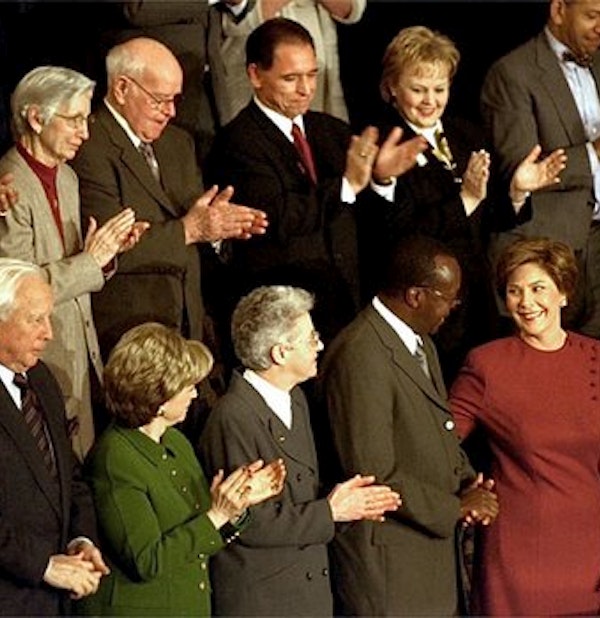Congress Can Break Through Polarization. Here's How.
We may think of Congress as the last place to see collaboration, but lawmakers can break through the current polarization. Lessons from the past show us the way.
 Mrs. Laura Bush turns to Peter Mugyenyi of Uganda, whose work was instrumental in the development of PEPFAR, during President George W. Bush's State of the Union address at the U.S. Capitol Tuesday, Jan. 28, 2003. (Susan Sterner / White House)
Mrs. Laura Bush turns to Peter Mugyenyi of Uganda, whose work was instrumental in the development of PEPFAR, during President George W. Bush's State of the Union address at the U.S. Capitol Tuesday, Jan. 28, 2003. (Susan Sterner / White House)
In recent times, policymaking has had a bad reputation. It’s often the last place we think of for collaboration and finding common ground. But it doesn’t have to be that way. Examples of successful policymaking in the past can serve as lessons for how we advance solutions and find common ground in the future.
Belief in the strength of our institutions is low, with Congress having particularly abysmal ratings. Congressional job approval stands at 16% as of early June 2022, and it’s been hovering around that figure for the past 10 years.
Relatedly, polarization has been increasing, both among our citizens and in the halls of Congress. Studies show that public views of issues polarize when they are told the policies they are evaluating are supported or opposed by the other party. We are easily convinced of a particular policy’s merits — or lack thereof — not by the substance, but merely by knowing whether the party on the other side of the aisle is in support or opposition.
But, again, it doesn’t have to be this way. Americans generally have viewed bipartisanship as a priority and want to see progress. So, what are the ingredients to policymaking that garner widespread support? Several examples over the past 20 years can illustrate the actions that lead to success — from the overwhelming bipartisan support of the No Child Left Behind Act in 2002 to the backing that a program like the President’s Emergency Plan for AIDS Relief (PEPFAR) has seen over four presidencies.
Americans generally have viewed bipartisanship as a priority and want to see progress.
 On January 8, 2002 President Bush signs into law historic, bipartisan No Child Left Behind education legislation. (White House photo by Paul Morse)
On January 8, 2002 President Bush signs into law historic, bipartisan No Child Left Behind education legislation. (White House photo by Paul Morse)
Ingredients for success
First is agenda-setting. Public attention needs to be raised on an issue so that it is seen as a priority. This often happens proactively by a policymaker in a leadership position. President George W. Bush made education reform the significant domestic priority of his run for the White House in 2000.
Other times it’s the result of a tragedy or crisis. President Bush proposed PEPFAR at a time when the rate of AIDS infection, particularly in Africa, was leading to debilitating suffering and death; in the early 2000s, an estimated 36 million people were living with HIV/AIDS and nearly 22 million lives had been lost. Recent gun legislation that made it to President Joe Biden’s desk is an example where the tragic shootings in Uvalde and Buffalo spurred Congress to act after a long period of inaction.
Second, a strong communications message and a coalition of support help an issue gain momentum. It’s particularly important to set an inclusive, optimistic tone if you are looking to gain support from both political parties. In the case of the No Child Left Behind Act, the name of the law was also the policy; people understood the goal by virtue of the name.
President Bush frequently talked about the “soft bigotry of low expectations,” imploring Americans to set their sights higher for our students. A strong and unexpected coalition between the civil rights and business communities lobbied Congress to pass the bill. PEPFAR likewise brought together the faith community with AIDS activists and the private sector — groups that often don’t see eye to eye — but are powerful when aligned.
In both cases when coalitions of “strange bedfellows” were working together, it was also important for each side to get some kind of win in the negotiations. In the case of No Child Left Behind, Republicans gained a new initiative to provide after-school tutoring to students via private providers, and Democrats pushed for a requirement around the definition of highly qualified teachers in the classroom.
The third ingredient is a clear and widely known set of principles to guide the policy. From the start, there needs to be an outline of the major policy changes that are desired as well as a set of principles to guide the details. This is particularly important as you get to drafting legislation and negotiating between the two parties.
For No Child Left Behind, these principles included annual state assessments of student achievement, the reporting of those test results by such categories as race and gender, the goal that all students would be on grade level in reading and math within 12 years, consequences for schools not meeting their targets, and research-based reading instruction. Both parties were generally on board with those goals, although differences in approach had to be worked out. Democrats also pushed for a significant increase in funds; that was made clear early-on in the process, and Republicans knew they would have to commit to increased spending.
PEPFAR introduced a new model for foreign assistance by focusing on locally designed strategies with accountability for outcomes in addressing HIV/AIDS. Both of those principles were essential to gaining support across the aisle.
Finally, it’s vital to pay attention to passage of a measure and know what it will take to get the required votes. Understanding how each member of Congress will vote is important throughout the process, and the bill authors and negotiators need to constantly stay in touch with legislators to understand what will cause each of them to vote “no.” No Child Left Behind and PEPFAR both passed by wide margins in the House and Senate, with large majorities of each party in support.
One other issue to consider is that the overall makeup of the two branches of Congress and the presidency have some influence on whether legislation is more or less bipartisan. Divided government — when one party controls the executive branch and another party controls one or both houses of Congress — generally leads to more bipartisanship.
Pursue a realistic path on immigration
While education and global health saw success, immigration has had a different fate. Congress has attempted to reform our broken immigration system several times over the past 20 years, and while passage was close several times, it never gained enough support to make it to the president’s desk. Why did it suffer a different fate?
I’d argue there are several reasons we haven’t seen progress. The coalition supporting immigration reform will need to get stronger and louder. The issue gets too politicized and is consistently used as a wedge issue in elections; it will require a president to expend significant capital.
The immigration principles of the two parties also are currently too far apart to get enough support and momentum. The most realistic next step is for a smaller bill tackling just some components of immigration reform to gain momentum.
Policymaking is a balancing act and requires tenacity. It takes vision, strategy, coordination, and the ability to give and take. That’s especially true when working across party lines to find common ground. Let’s hope that it’s not a dying art.
The Catalyst believes that ideas matter. We aim to stimulate debate on the most important issues of the day, featuring a range of arguments that are constructive, high-minded, and share our core values of freedom, opportunity, accountability, and compassion. To that end, we seek out ideas that may challenge us, and the authors’ views presented here are their own; The Catalyst does not endorse any particular policy, politician, or party.



